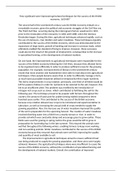Natalie
‘How significant were improved agricultural techniques for the success of the British
economy, 1650-88?’
The second half of the seventeenth century saw the British economy embark on a
remarkable recovery, given the political and economic struggles of the Civil War era.
The Third Civil War, occurring during the Interregnum Period, would end in 1651,
prior to the restoration of the monarchy in 1660 until 1688, when the Glorious
Revolution began. During this time, agricultural techniques advanced rapidly, such as
the use of enclosure, crop rotation and water meadows. These techniques arguably
contributed to the success of the British economy, which was demonstrated by the
expansions of large towns, growth of banking and increase in overseas trade, which
ultimately enabled the standard of living to improve. However, these successes
could also be the result of the growth of employment, consequential to the increase
in specialised farming, or the development of national markets.
On one hand, the improvements to agricultural techniques were responsible for the
success of the British economy following the Civil Wars, because they allowed farms
to be organised more efficiently in order to produce sufficient crops for the growing
population. For example, increased levels of literacy in the seventeenth century
meant that more yeomen and husbandmen were able to read about new agricultural
techniques. More people became aware that, in order to efficiently manage a farm,
as much land as possible should be utilised or temporarily left to regain nutrients.
This led to improvements in crop rotation: previously, one-third of all fields would be
left for pasture (fallow) in order for nutrients to be restored to the soil, however, this
led to an insufficient yield. This problem was rectified by the introduction of
nitrogen-rich crops such as clover, which contributed to fertilising the soil for the
following year. The technique proved to be popular with farmers throughout the
country: the amount of land used for arable farming tripled compared to three
hundred years earlier. This contributed to the success of the British economy
because crop rotation allowed new crops to be introduced and experimentation to
take place, as well as increasing the annual yield of crops needed to supply the
growing population. Also, the increase use of water meadows improved the quality
of the soil in preparation for the upcoming harvest. The creation of water meadows
involved diverting water into a field from a nearby stream or river, in order to
provide soil which was constantly damp and encourage grass to grow earlier. These
fields were used for grazing in spring, before the grass would be left to grow in
preparation for harvesting hay in the late summer. This ensured the animals were
well fed throughout the following winter, enabling farmers to keep more working
and non-working animals. Water meadows contributed to the success of the British
economy because they ensured that animals were well fed, improving the quality
and quantity of meat available to sell.
The improvements in agricultural techniques aimed to ensure sufficient food
was being produced to supply the growing population, and these aims were largely
achieved. However, the agricultural techniques alone were insufficient to cause the
success of the British economy, without the contribution of specialised farming and
the development of national markets. Overall, the contribution of improved





